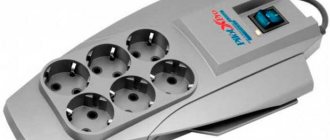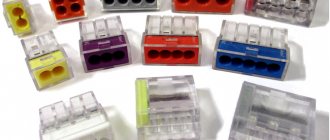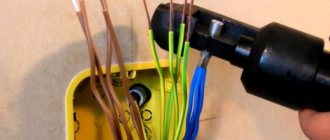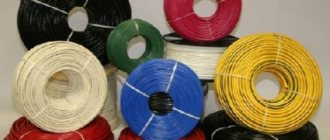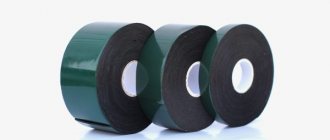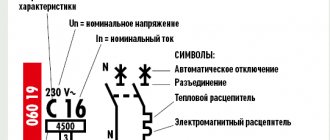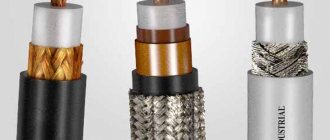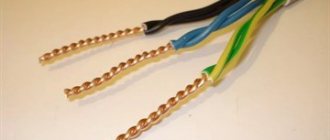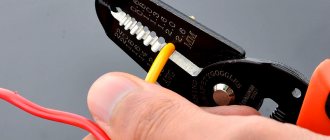Types of cambrics
The materials from which the tubes are made allow them to be classified into several main types:
- PVC cambrics;
- Tubes, in the production of which materials based on cotton fabrics are used;
- Heat-shrinkable casings;
- Heat resistant.
Heat-shrinkable cambrics are divided into:
- Fluorescent tubes that glow and are used where lighting is limited;
- High voltage, having resistance and used for high voltage;
- Teflon, resistant to fire and chemical environments;
- Having a corrugated surface, used in areas where it is necessary to provide friction and prevent slipping.
DIY installation
To properly install the tube, you must adhere to a number of rules. At the preliminary stage, perform the following actions:
- Select the appropriate size and brand of heat shrink tube.
- Determined by the amount of material.
- Study the available offers on the market.
- Prepare the working tool.
Note! The choice of tool is especially important, since for different brands of heat shrink the difference in operating temperature can be more than a hundred degrees. The following tools can be used to install the tube:
The following tools can be used to install the tube:
- construction hair dryer;
- heat gun;
- portable gas burner;
- gas soldering iron;
- propane torch;
- infrared burner.
Installation of heat shrinkage is carried out in the following sequence:
- Dirt, dust and any foreign particles are removed from the conductors.
- The heat shrink is cut into pieces of the required length.
- Next, the prepared section of heat shrink must be put on the entire wire.
- Using a hair dryer, torch or soldering iron, heat the heat shrink.
The best equipment option for installing heat shrink is a heat gun. It is possible to set the desired shrinkage temperature, which facilitates the installation process.
The heating and installation operation is carried out according to the following algorithm:
- Tubes with a large cross-section are first heated to 50% of the nominal temperature required for shrinkage. The same applies to wide flexible tapes. Heat shrinks with thin walls or small diameters do not require preheating.
- Cut the required length of the tube using regular scissors. You need to cut carefully so as not to leave any unevenness on the edges of the product.
- The tube is slightly stretched and put on the desired area.
- Heat the heat shrink to the nominal temperature using a heat gun or other heating tool. The temperature must not be exceeded, as in this case the surface will be deformed.
- After heating, you need to let the material cool. At this time, no mechanical influences should be exerted on the structure.
Some useful tips for installing heat shrink tubing:
- In the case of heat shrinks of large length or diameter, it is better to start heating from the middle part of the product. Next, the burner is moved towards the edges.
- If it is unclear whether the length of the tube is sufficient, it is recommended to start warming up from the end of the product where the communication plug, wire tip, etc. is installed.
- If heat shrink is installed on a metal base with high thermal conductivity, this surface must be thoroughly heated before installation.
- There should be no sharp edges on the surface to be coated.
- There is no point in stretching heat shrink tubing that is not long enough. The consequence of such actions will be the loss of heat shrink strength and dielectric properties.
Heat-resistant cambrics
This type of thermal insulation tube is made of high temperature resistant fiberglass materials. They do not corrode or burn, and are able to maintain their shape under conditions of moderate mechanical load.
- For cambrics, fiberglass is impregnated with resins and polymers, and therefore has good insulating properties.
- Fluctuations in the operating temperature of devices occur from -600C to +5300C. Fiberglass retains its structure even at very low temperatures.
- There are types of tubes with solder inside. That is, inside a heat-resistant plastic tube, there is a solder rim.
- It melts when heated and envelops the twists of the cores, which must first be tinned.
In addition, the device contains rings along the edges that resist movement and hold the tube in place.
Structure
The color marking of cambrics is developed and produces models with more than 100 shades. You can also order a color of your choice. Clear tubes available. Designed for more careful installation. They are easy to label. They have poor heat resistance.
You might be interested in this Description of the KG cable
The manufacture of cambrics occurs using polymers such as:
- Latex rubber;
- Fluorine rubber;
- PTFE;
- PVDF;
- PET;
- cross-linked polyethylene.
Insulating tubes with markings
Using heat-resistant cambrics
Such insulation is rarely used in cases of installation of electrical networks. More often this happens when installing and connecting heating devices: automatic cabinets, drying chambers, induction furnaces.
The cambric not only serves to protect the conductors, but also the connection points from the influence of high temperatures.
What are they intended for?
Cambriks are used to restore insulation in wires. Additional protection against current occurs due to the insulation of tips and terminal blocks.
Main purposes:
- protects electrical buses with different shapes and sections;
- protects bolted and other products from corrosion;
- increases protective qualities in switchgears;
- used as additional insulation in electrical substation equipment elements;
- heat-resistant cambrics protect the wire from overheating;
- intended for marking wires;
- protect wires and chargers from kinks.
Protecting the charging wire from breaking
Performance characteristics of heat resistant tubes
Heat-resistant cambrics are distinguished by the following:
- They do not burn and are resistant to high temperatures;
- They have a high level of electrical impermeability - the material does not allow the conduction of electric current;
- The diameters of the cambrics have a wide range - from 10 to 150 mm;
- The operating temperature ranges from -600C to +5300C (the influence of low temperatures does not change the structure of the cambric);
- The wall thickness is from 2.5 to 3.0 mm, which makes the work difficult, but at the same time it is a certain obstacle to the direction of electric current.
Specifications
Silicone varnish is applied to the fiberglass layer of the tube.
The high-temperature consumable is characterized by:
- Quality to withstand temperatures with a maximum of +4000C;
- Dielectric density from 800 to 1200 V;
- The inner diameter of the tube is from 3 to 150 mm;
- Duration of use at temperatures from -600C to +3500C;
- Tolerance plus/minus 25 mm;
- Wall density of 0.4 mm.
The material is non-flammable, durable, does not allow current to pass through, has excellent thermal conductivity, black or white shell.
Where is it used?
Used in the following cases:
- When protecting wiring with the connection of cartridge and clamp heating elements;
- To protect electrical thermal equipment - drying chambers and heating plates;
- Close connections with heat-resistant properties;
- For insulating cables of household appliances - hair dryers, boilers, irons and soldering irons.
Purpose of the product
Heat shrink tubing was originally used to insulate and protect wires, but it has many different uses. We'll talk about this a little later, but now we'll look at what goals can be achieved by using it in everyday life:
- Protection of any connections from moisture and water leaks. For example, you can connect two tubes or the junction of a pipe and a battery.
- Protection of connections from ultraviolet radiation, dirt, mechanical damage, corrosion. Since the tube does not allow moisture to pass through, rusting does not begin underneath it and corrosion does not occur.
- Surface protection from chemical reagents. The polymer is not afraid of contact with aggressive environments.
- Protecting surfaces or joints from deformation.
- Possibility of repairing cuts and other defects in cable insulation, insulation of wires and connections.
- Marking of wires in different colors.
The material is used wherever there are wires and cables - in car repairs, creating wiring, restoring household appliances and various electrical equipment. It is used when installing alarms or head units on cars, protecting connections of hoses with filters or other devices, used in plumbing, etc. A wide range of colors and diameters of heat-shrinkable tubes opens up great opportunities for repairing and insulating various surfaces.
Heat shrink sleeves
They are distinguished by their manufacture from polymers that have the ability to shrink several times (1.5-2.0) when heated. At the same time, it is allowed to use the same size for wires with a larger diameter. The optimal shrinkage ratios are 1:4, 1:3, 1:2.
Cambriks are capable of insulating connections and terminals with different characteristics, because the shape does not affect the properties of the covering - the cambric copies and shortens to the desired contour.
In addition to its shrink properties, the tubing can stretch, but stretching must be done carefully.
The positive side is that heat-shrinkable tubes are produced in colored or transparent, as can be seen in the photo of the cambrics. This allows you to mark wires according to their purpose, dividing them into groups.
The disadvantages include a low melting point. When the temperature reaches +2000C, they can spread.
Positive traits:
- Low cost.
- It can be used as a basis for marking - a light cambric placed on the wire can be signed. It also helps restore worn-out markings.
- Quite durable material.
- Universal - a correctly selected diameter allows the installation of cambrics on any current-carrying areas.
- Reusable.
- Withstands high temperatures.
- Length of service life.
- When ignited, there is almost no release of harmful substances.
- Processes of corrosion and oxidation of contacts are excluded.
- No interaction with chemicals.
Heat-shrinkable tubes are popular among specialists for their availability and practicality. High temperature can be achieved with a hair dryer, matches, lighter or soldering iron.
The consumable is multifunctional and can be used both as a connection of conductors and for laying signal networks or telephone lines at low voltage and current.
Criterias of choice
To choose the correct cambric size, you need to add 2 mm to the wire diameter.
When purchasing cambrics, you should pay attention to several parameters:
- Diameter of the inner part. The optimal size is from 1.5 to 2 core diameters. Manufacturers mark this value before shrinkage (numerator of the fraction) and after shrinkage (denominator of the fraction).
- Range of reduction of the polymer layer. The acceptable parameter is from 1.5 to 2 times.
- Reinforcement. Fiberglass models are hard, while cotton models allow you to fix the wire in a certain position.
- Resistance to hazardous reactions. Antiprene tubes are durable and resistant to fire.
- Color. Thick multi-colored or transparent thermal tubes are available for sale.
- Length. The casings are sold in lengths or as cable strands.
Dimensions are indicated in inches and centimeters.
How to choose cambrics
Since the main qualities of different types of insulating tubes are given, it remains to figure out which tubes are better for wires. When making a choice, one must proceed from the situation of using insulating materials.
- If it is necessary to prevent a short circuit between several adjacent parts, it is better to use heat shrink tubing.
- At high temperatures, the cambric will be able to compress the open areas of the connections, having significant resistance.
- In addition, there is no need to accurately select the diameter of the cambric, because its ability to shrink makes it possible to have a difference with the diameter of the cable (wire) of only a few millimeters.
Heat shrink tubing is most convenient for all types of wire connections. For laying electrical circuits, it is important to use cambrics.
The consumable has a fairly budget price, which makes it in demand. Ease of use allows people without experience to work with it. Cambric is a reliable protection for conductors and various connections, having high resistance and immunity to fire.
Main purpose
Reliable insulation at the connection point - this is the main purpose of heat-shrinkable tubing. These works, in which heat shrink is applied to wires, are very common among electricians, electricians and electronics engineers. Craftsmen encounter it no less often in their household activities. The heat-shrinkable materials of such tubes can shrink sharply when heated starting from a certain temperature. The shrinkage temperature is approximately 110–130 degrees Celsius. In this case, the deformation covers the diameter of the heat-shrinkable tube to a greater extent. On average, this is a twofold decrease. The dimensions decrease slightly along the length.
The temperature characteristics of the materials used for tubes may vary by up to 60 degrees Celsius.
Heat modified conduit is available in a variety of diameters and colors that must be selected for the specific connection. There are also transparent heat-shrinkable tubes. A piece for thermal shrinkage, made a couple of centimeters longer than the future twist, should easily fit onto one of the wires intended for connection. After twisting the wires, it is placed so that the cambric, which insulates the twist, overlaps the insulation of each wire at the same distance.
The heat shrink tube compresses the installation site with quite a lot of force. For this reason, channels are formed between the stretched insulating material and the irregularities of the object being pressed, which make the joint leaky. If you need to achieve good sealing, for example, to protect the conductor from moisture penetration, you need to use a tube with a layer of hot-melt adhesive. When the tube is heated, the glue liquefies and fills the irregularities through which moisture could penetrate to the connected wires.
